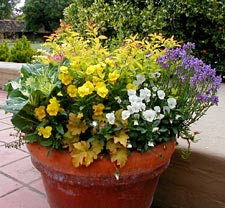
The popularity of container gardening is exploding. Municipalities, park districts, and businesses are leading the way with colorful planters and urns that change with the seasons. The convenience of containers makes it possible for homeowners and apartment dwellers to join the fun, too.
The first step is selecting the containers. Your choices depend on your space and the type of plants you want to grow. Pots should have drainage holes so roots don't sit in water and rot. Only a few plants (e.g., calla lily, rain lily, water iris) can survive in containers without drainage holes.
Terra-cotta, wood, and other porous materials have the best drainage, which has advantages and disadvantages. The better the drainage, the less chance of root rot, but the greater the chance of roots drying out. If you are a forgetful gardener or if you travel a lot during the summer, choose a less porous container.
Ceramic, plastic, and other solid materials hold water much longer. Use this to your advantage. I often plant annuals in a terra cotta pot with a drainage hole and then insert the pot inside a ceramic container. This gives the best of both worlds by greatly reducing the amount of watering yet also reducing the chance of root rot. Plus the ceramic pot is more decorative.
The other consideration when choosing a container is weight. Toting a large ceramic container or wooden barrel up flights of stairs can be tough. Ease of transport is definitely a factor that affects your enjoyment of gardening. Plus, you need to consider the weight limits of your balcony and the strength of the wind. Check with your condo association for balcony limits. As far as wind goes, you have to make an educated estimate. If you have lots of breezes with the occasional gust, you may not want to choose lightweight plastic pots, especially for tall plants, because they may tip over. Heavier pots are better for windy areas.
I recommend a good quality, sterile soilless mix that's formulated for container growing. There are many types on the market. Avoid using topsoil or compost that has not been sterilized. If planting in lightweight plastic pots, you can add sand to the mix to increase the weight. If using heavy pots, perlite is a good amendment for reducing weight. My favorite container amendment is lava rock, which is relatively lightweight and has lots of pore spaces to hold air, water, and nutrients.
Like any endeavor, start small at first. Plant a few containers to feel
your way and see what works best for your particular site and taste. In
a short time you will have containers brimming with foliage, flowers,
and maybe even fruit.